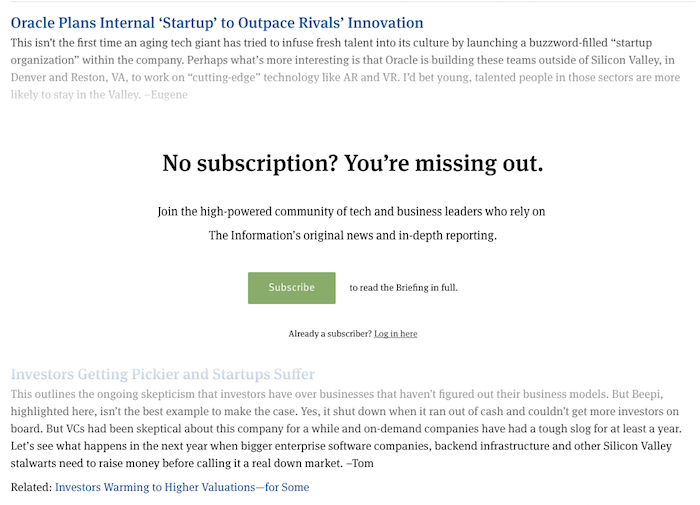
When The Information launched in 2013, the whole point was that it would provide in-depth, exclusive articles — just one or two a day — over aggregated content and news summaries. “It’s for the audience who aren’t just scanning the headlines, but those who come read a publication on a deeper level,” founder and CEO Jessica Lessin told All Things D.
But times change (All Things D became Re/code became Recode) and, while The Information isn’t dropping its focus on exclusive reporting, it is recognizing that even for audiences that care about more than scanning headlines, some summarization can be useful. It doesn’t hurt that briefings are kinda hot these days, especially as publishers embrace email newsletters as the thing that just miiiiight be able to break through (The New York Times’ Morning Briefing emails are now up to 1.5 million subscribers, the company announced this week, and it’s expanding the briefings to Snapchat). So Lessin announced on Tuesday at The Information’s subscriber summit in New York that the publication is launching a briefing — called simply, with no articles or adjectives, Briefing (meaning someone else can still grab the title “Brief” if they want it). The Information is now up to “paying subscribers in the double-digit thousands,” a figure that’s doubled since last year, the company says. (A subscription is $399 a year or $39 a month, unchanged since 2013, though the company has added a higher-priced premium tier as well as student subscriptions.) A briefing was something that subscribers had been asking for since the beginning, Lessin told me, “but I wanted to make sure that our team was big enough and we had the breadth of expertise to continually deliver something valuable. We’re at a point now [with 13 full-time reporters] where we can meet that demand.”The Information’s Briefing doesn’t really aim to be a Techmeme-like, factual snapshot of the biggest news of the day. Rather, “we think there’s a real opportunity to provide some perspective,” Lessin said. Each item in Briefing links to one article, with one of The Information’s reporters commenting on “what the article got right, what’s new about it, what other factors to consider — like if the sourcing is skewed toward one side or another. It’s a way we seek to inform our subscribers about the news we don’t write.” (A model in another space might be Politico Playbook, or Mike Allen’s Axios AM.) One item, for example:
Square Sort of Acquihires Yik Yak
This deal, which seems like a routine acquihire, isn’t so routine. Remember: Yik Yak was once the next Snap, and investors went crazy to get in on it and appeal to “young people.” Its failure is as much a failure of thesis and demographic-driven investing as anything. Also, acquiring an engineering team, which happened in this case, isn’t really an acquisition. I suspect that angle came from investor spin. —Jessica
Briefing is updated all day long (by reporters in Hong Kong, San Francisco, and New York), and the email version for subscribers will serve as a static snapshot. The company will experiment with the timing of the email, but for now it’s being sent out late afternoon Pacific time.
Ultimately, The Information might also include subscribers in the creation of Briefing. “In Slack, subscribers suggest articles to us all the time,” Lessin said. “I’d love to harness that in this product, too. That might be phase two.”